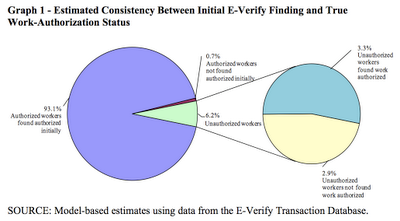Recently, some media reports have used statistics that appear to call into question the effectiveness and accuracy of E-Verify. I’d like to set record straight. A report by the independent research firm Westat, using a sample from a three month period in 2008, concluded that E-Verify was accurate 96 percent of the time. Since then, the Obama administration has taken significant steps to further improve E-Verify.
Read the report for yourself here.
What else did this report tell us about E-Verify?
- 93.8 percent of workers screened by E-Verify were authorized for employment—and the system instantly and accurately confirmed more than 99 percent of these eligible workers.
- The remaining 6.2 percent were not eligible for employment. Out of this estimated 6.2 percent, approximately half were told they are work authorized when they were not—just 3.3 percent of the overall population screened by E-Verify.
- To be clear, this means that only an estimated 3.3 percent of all workers screened by E-Verify were incorrectly told they were work authorized.
The system’s accuracy and efficiency continues to improve, reflecting the changes and improvements to E-Verify that USCIS has made over the past year—and continues to make. Our anti-fraud efforts are improving E-Verify’s ability to prevent illegal workers from using stolen identities to obtain employment—including a photograph screening capability that allows a participating employer to check if photos on Employment Authorization Documents (EAD) or Permanent Resident Cards (green cards) are exact matches with the images stored in USCIS databases.
Our anti-fraud efforts are improving E-Verify’s ability to prevent illegal workers from using stolen identities to obtain employment—including a photograph screening capability that allows a participating employer to check if photos on Employment Authorization Documents (EAD) or Permanent Resident Cards (green cards) are exact matches with the images stored in USCIS databases.
USCIS is also planning additional enhancements to E-Verify that will further improve employer compliance, reduce fraud and increase efficiency. We are adding U.S. passports to the list of documents available to provide photo confirmation, and working with states to access state driver’s license data—the #1 document used to validate identity. We’re also planning to launch a pilot program to explore the use of biometric or biographic-based verification.
Employers at more than 600,000 worksites nationwide used E-Verify to check the work authorization status of more than 8.5 million workers during fiscal year 2009, and E-Verify has processed more than five million queries during the last five months alone.
Quite simply, E-Verify ensures a legal workforce while protecting the rights of employers and employees alike—accurately, easily and efficiently. It is critically important to a legal workforce and directly impacts national security and our economy. The ultimate success of E-Verify will rely on public-private cooperation, and we are committed to continuing to work with all of our partners to improve this tool.
Lauren Kielsmeier is the Acting Deputy Director and Chief of Staff for U.S. Citizenship and Immigration Services
